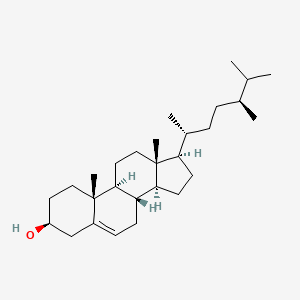| MeSH term | MeSH ID | Detail |
|---|---|---|
| Coronary Disease | D003327 | 70 associated lipids |
| Hypercholesterolemia | D006937 | 91 associated lipids |
| Hyperlipoproteinemia Type II | D006938 | 22 associated lipids |
| Hyperlipidemias | D006949 | 73 associated lipids |
| Hypolipoproteinemias | D007009 | 9 associated lipids |
| Xanthomatosis | D014973 | 17 associated lipids |
| Metabolic Syndrome | D024821 | 44 associated lipids |
22,23-dihydrobrassicasterol
22,23-dihydrobrassicasterol is a lipid of Sterol Lipids (ST) class. 22,23-dihydrobrassicasterol is associated with abnormalities such as Diabetes, Macular degeneration, Drusen, Systemic disease and Diabetes Mellitus. The involved functions are known as cholesterol metabolism, Synthesis, Intestinal Absorption, Liver function and cholesterol absorption. 22,23-dihydrobrassicasterol often locates in Back and Cell membrane. The associated genes with 22,23-dihydrobrassicasterol are apolipoprotein E-3. The related lipids are Total cholesterol, campesterol, lathosterol, Fatty Acids, Nonesterified and Cholesterol, Dietary.
Cross Reference
Introduction
To understand associated biological information of 22,23-dihydrobrassicasterol, we collected biological information of abnormalities, associated pathways, cellular/molecular locations, biological functions, related genes/proteins, lipids and common seen animal/experimental models with organized paragraphs from literatures.
What diseases are associated with 22,23-dihydrobrassicasterol?
22,23-dihydrobrassicasterol is suspected in Diabetes, Macular degeneration, Drusen, Systemic disease, Diabetes Mellitus, Liver diseases and other diseases in descending order of the highest number of associated sentences.
Related references are mostly published in these journals:
| Disease | Cross reference | Weighted score | Related literature |
|---|
Possible diseases from mapped MeSH terms on references
We collected disease MeSH terms mapped to the references associated with 22,23-dihydrobrassicasterol
PubChem Associated disorders and diseases
What pathways are associated with 22,23-dihydrobrassicasterol
There are no associated biomedical information in the current reference collection.
PubChem Biomolecular Interactions and Pathways
Link to PubChem Biomolecular Interactions and PathwaysWhat cellular locations are associated with 22,23-dihydrobrassicasterol?
Visualization in cellular structure
Associated locations are in red color. Not associated locations are in black.
Related references are published most in these journals:
| Location | Cross reference | Weighted score | Related literatures |
|---|
What functions are associated with 22,23-dihydrobrassicasterol?
Related references are published most in these journals:
| Function | Cross reference | Weighted score | Related literatures |
|---|
What lipids are associated with 22,23-dihydrobrassicasterol?
Related references are published most in these journals:
| Lipid concept | Cross reference | Weighted score | Related literatures |
|---|
What genes are associated with 22,23-dihydrobrassicasterol?
Related references are published most in these journals:
| Gene | Cross reference | Weighted score | Related literatures |
|---|
What common seen animal models are associated with 22,23-dihydrobrassicasterol?
There are no associated biomedical information in the current reference collection.
NCBI Entrez Crosslinks
All references with 22,23-dihydrobrassicasterol
Download all related citations| Authors | Title | Published | Journal | PubMed Link |
|---|---|---|---|---|
| Brämswig S et al. | Carbamazepine increases atherogenic lipoproteins: mechanism of action in male adults. | 2002 | Am. J. Physiol. Heart Circ. Physiol. | pmid:11788421 |
| Beveridge TH et al. | Phytosterol content in American ginseng seed oil. | 2002 | J. Agric. Food Chem. | pmid:11829639 |
| Ostlund RE et al. | Gastrointestinal absorption and plasma kinetics of soy Delta(5)-phytosterols and phytostanols in humans. | 2002 | Am. J. Physiol. Endocrinol. Metab. | pmid:11882512 |
| Awad AB et al. | In vitro and in vivo (SCID mice) effects of phytosterols on the growth and dissemination of human prostate cancer PC-3 cells. | 2001 | Eur. J. Cancer Prev. | pmid:11916349 |
| Boggia R et al. | Classification and class-modeling of "Riviera Ligure" extra-virgin olive oil using chemical-physical parameters. | 2002 | J. Agric. Food Chem. | pmid:11929311 |
| Plat J and Mensink RP | Relationship of genetic variation in genes encoding apolipoprotein A-IV, scavenger receptor BI, HMG-CoA reductase, CETP and apolipoprotein E with cholesterol metabolism and the response to plant stanol ester consumption. | 2002 | Eur. J. Clin. Invest. | pmid:11952809 |
| Khripach VA et al. | [3,3]-Claisen rearrangements in 24alpha-methyl steroid synthesis. Application to campesterol, crinosterol, and Delta25-crinosterol side chain construction. | 2002 | Steroids | pmid:11996932 |
| Nissinen M et al. | Micellar distribution of cholesterol and phytosterols after duodenal plant stanol ester infusion. | 2002 | Am. J. Physiol. Gastrointest. Liver Physiol. | pmid:12016126 |
| Lindenthal B et al. | Serum plant sterols and biliary cholesterol secretion in humans: studies with ursodeoxycholic acid. | 2002 | J. Lipid Res. | pmid:12091491 |
| Khabazian I et al. | Isolation of various forms of sterol beta-D-glucoside from the seed of Cycas circinalis: neurotoxicity and implications for ALS-parkinsonism dementia complex. | 2002 | J. Neurochem. | pmid:12153476 |
